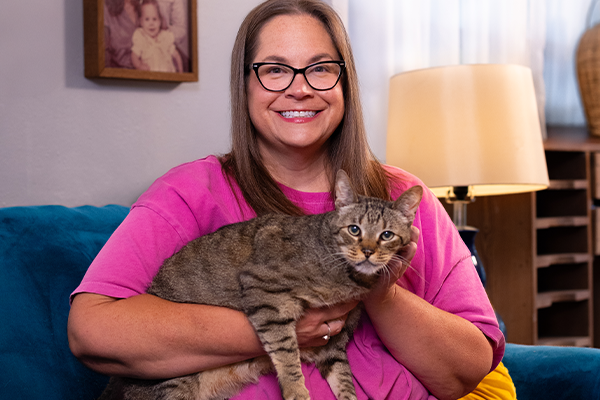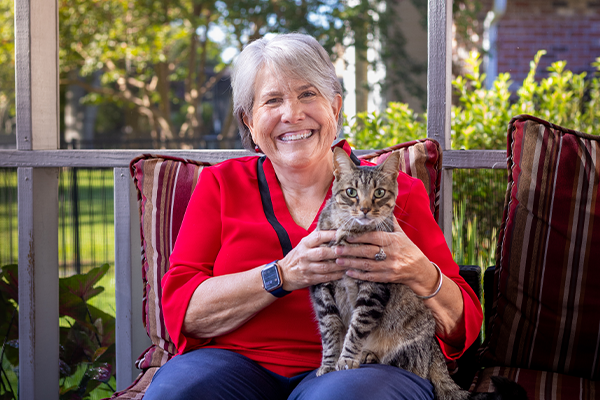Blood donor cats: Vital heroes of the LSU Veterinary Teaching Hospital
August 14, 2025

Onyx aged out of the blood donor program about two years ago and since then, has been enjoying his retirement. “Onyx is such a sweet boy,” said Cortez. “He loves to play fetch with anything that crinkles into a ball, he loves rolling around in the grass, and he’s such a big talker too! He'll just walk around the house all night talking.”
Nearly every hospital in the U.S. has a blood bank available for humans in need. Blood banks also play a crucial role saving the lives of animals. At the LSU Veterinary Teaching Hospital, a robust blood donation program ensures that every patient gets the care they need. At the center of the feline program are three current blood donor cats, Tiger, Leo, and Pete, who live at the school and play a vital role in making life-saving treatments possible.
“Every pet deserves a chance to be saved, and having blood on hand can mean the difference between life and loss for someone's best friend,” said Amber Cortez, former veterinary technician at LSU Vet Med. Cortez’s 10-year-old black cat, Onyx, is retired from the hospital’s blood donor program, donating blood until he hit the age limit of 8 years old.
Just like humans, cats have different blood types, ranging from the more common types, A and B, to the rare type AB. When cats come to LSU Vet Med suffering from conditions such as severe anemia, trauma induced blood loss, Feline Infectious Peritonitis, and others, they have a lifeline, a robust blood bank supported by 13 cats.
Tiger, Leo, and Pete are three of those 13 cats in LSU Vet Med’s blood donation program. They act as safeguards and are especially valuable due to the high emergency case load at the hospital.
“As a veterinary technician who has used the blood and plasma products for emergency and critical situations, I have personally seen many lives saved,” said Andi LaBorde, former veterinary technician at LSU Vet Med. “A blood donor program is so important in a veterinary hospital that sees emergency, critical care, and specialty surgical cases.”
Although blood can be bought from outside blood banks, it is costly and not consistently available in the quantities required. Animal blood has a short shelf life as well, making the need for immediate action even more important. Having a live-in donor program helps reliably maintain the blood bank that is crucial for a veterinary teaching hospital.
“Ordering blood takes time, even if it’s shipped overnight,” LaBorde said. “Having access to an in-house donor or being able to call in a donor to keep inventory full is so important.” Cats aren’t the only animals contributing to LSU Vet Med’s blood bank. The hospital also runs a canine blood donor program, made up of 11 owner-owned dogs. That program is open exclusively to LSU Vet Med faculty, staff, and students who volunteer their pets to help save lives.
The live-in donors reside within the new Stephenson Pet Clinic in a cozy habitat spanning two rooms with two large windows complete with window perches, blankets, toys, and kennels. Members of the Community Practice service take care of them and ensure they live a comfortable life. The cats only donate blood about three times per year, as needed, for their two years of service at the hospital.
“Our live-in cats’ needs are of the utmost importance to Community Practice,” said Torri Collins-Cannon, a veterinary technician who oversees the blood donor program along with Associate Professor of Community Practice, Dr. Nancy Welborn.
Under an Institutional Animal Care and Use Committee (IACUC) protocol, LSU follows specific rules regarding who can handle and interact with the cats to ensure their safety and comfort. Even with these rules, the live-in donors get plenty of attention. Walking down the hallway, you can often see a staff member or a student in the hospital interacting with them.
After the live-in donors fulfill their two years of service at the hospital or reach the age limit of 8 years old, they are all adopted, usually by LSU Vet Med faculty or students. The word is spread around the hospital and school, and anyone who would like to adopt a retired donor must fill out an application.
“We have a 100% adoption rate,” Dr. Welborn said. “We know their personalities and what would work well, so we do talk to potential adoptees to make sure that the cat’s retirement is to a place that is a good fit because they have done a really important job for us.”
Over the years, hundreds of cats have passed through LSU Vet Med’s blood donor program, each of them playing their own important role at the hospital. As a former technician in the hospital, LaBorde not only interacted with them professionally, but she also welcomed two of them into her home permanently.

Former Veterinary Technician, Andi LaBorde, poses with LSU Vet Med’s most prominent blood donor from 2014-20, Willie Nelson. Not pictured is LaBorde’s other retired donor, Herb, who was not camera ready.
In 2013, LaBorde adopted Willie Nelson as a kitten, and as soon as he became old enough to become a blood donor, she enrolled him. She recalls being told one day by Ophthalmology Technician, Leigh Ann Burton, that Willie Nelson’s blood had been used in an emergency transfusion for her mother’s cat, saving its life. From 2014 to 2020, Willie Nelson donated blood, becoming one of the hospital’s most frequent donors.
In 2017, LaBorde also adopted Herb, a retired live-in blood donor at the hospital, as a companion for her cat, Willie Nelson. A brown tabby like Willie, Herb reminded LaBorde of him, so she decided to bring him home. Now retired, both cats live with LaBorde and have become close friends.

Senior Director of Alumni Relations, Gretchen Morgan, adopted Party Marty, a live-in donor, in 2020. She said he was given the name as he “likes to party.” Every time someone would walk through the door, he’d come immediately to greet them. He continues this tradition in his retirement, greeting everyone who walks through Morgan’s front door.
Party Marty was a live-in blood donor during 2018-19. Senior Director of Alumni Relations, Gretchen Morgan, adopted him in 2020 and he now lives out his retirement with her.
As they approach the two-year limit, Tiger, Leo, and Pete will soon be adopted out and join Onyx, Herb, Party Marty, and Willie Nelson in retirement, officially becoming the newest retired blood donor heroes of the LSU Veterinary Teaching Hospital.
LSU Vet Med honors every blood donor animal that has contributed to the program, along with their generous owners who have volunteered their time to help save countless lives through the blood donor program.